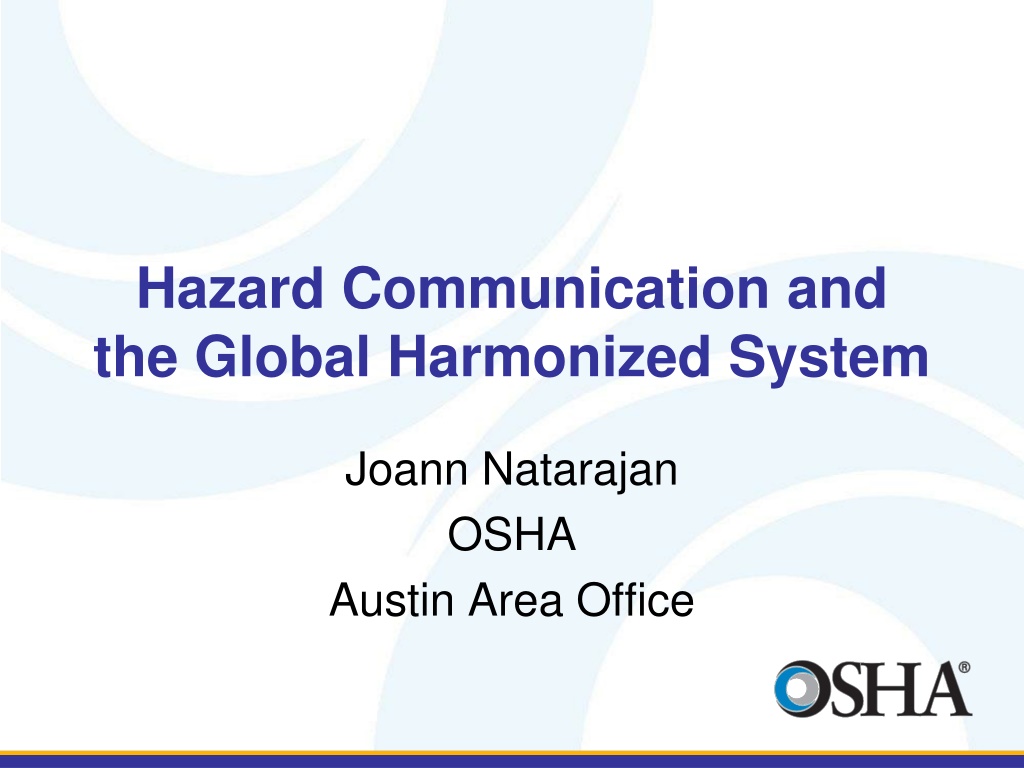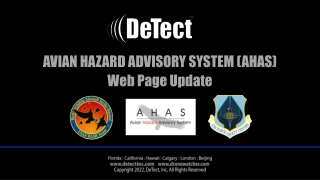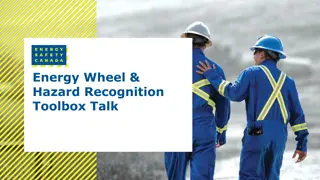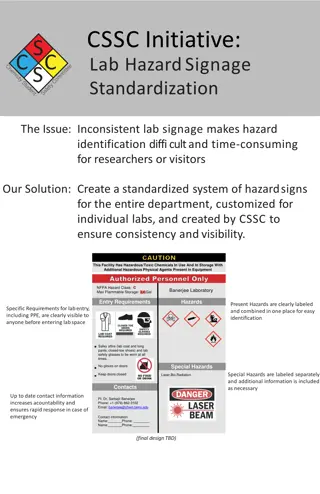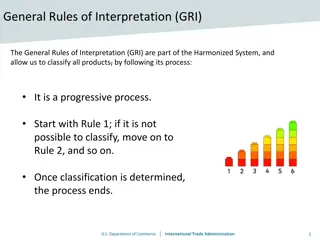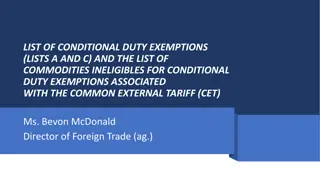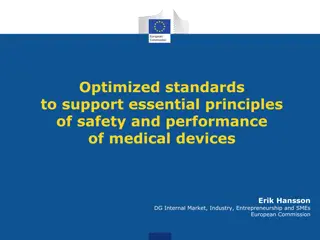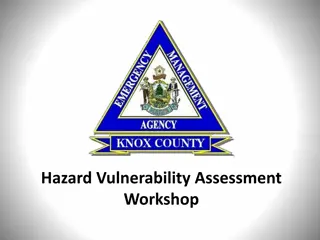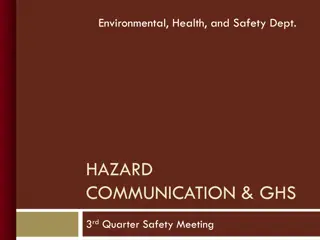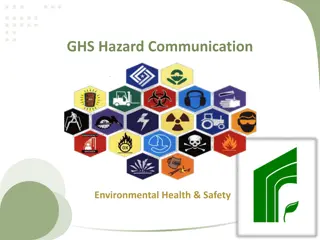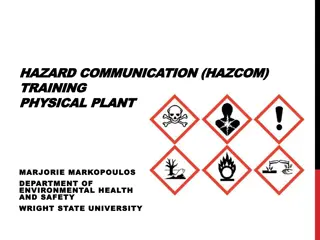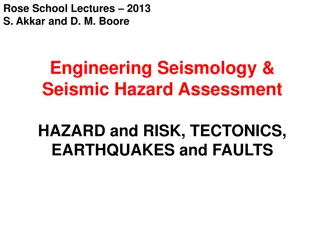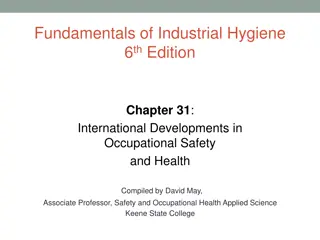Understanding Hazard Communication and the Global Harmonized System
This content discusses the changes introduced by the Global Harmonized System in Hazard Communication Standards (HCS). It highlights the impact on classifications, labels, safety data sheets, and information and training requirements. The GHS aims to enhance workplace safety by providing a standardized framework for hazard communication, affecting millions of workers and workplaces globally. The Hazard Classification criteria for both health and physical hazards are outlined, emphasizing the importance of these classifications in promoting a safe work environment.
Download Presentation

Please find below an Image/Link to download the presentation.
The content on the website is provided AS IS for your information and personal use only. It may not be sold, licensed, or shared on other websites without obtaining consent from the author. Download presentation by click this link. If you encounter any issues during the download, it is possible that the publisher has removed the file from their server.
E N D
Presentation Transcript
Hazard Communication and the Global Harmonized System Joann Natarajan OSHA Austin Area Office
What Has Changed? Issued March 26, 2012 Affects 29 CFR 1910.1200 Affects other regulations: Welding Flammables, and substance specific standards Label and hazard warnings were harmonized in the substance specific regulations 2
GHS The major changes to the HCS: Hazard Classification Labels Safety Data Sheets Information and Training Will affect nearly 40 million workers and 5 million workplaces
GHS It is estimated that implementing the GHS will prevent 43 fatalities and 585 injuries and illnesses annually The DOT has already modified their requirements for classification and labeling to be consistent with UN transport requirements and the GHS
GHS Hazard Classification The list of chemicals presenting a Health hazard was deleted from the current HCS and the proposed HCS has identified a new listing A Health Hazard means a chemical which is classified as posing one of the following hazardous effects:
GHS Hazard Classification Acute Toxicity (any route of exposure) Skin Corrosion or Irritation Serious Eye Damage or Eye Irritation Respiratory or Skin Sensitization Germ Cell Mutagenicity Carcinogenicity Reproductive Toxicity Specific Target Organ Toxicity (single or repeated exposure) Aspiration Hazard
GHS Hazard Classification The list of chemicals presenting a Physical hazard was deleted from the current HCS and the proposed HCS has identified a new listing A Physical Hazard means a chemical that is classified as posing one of the following hazardous effects:
GHS Hazard Classification Explosive Flammable (gases, aerosols, liquids, or solids) Oxidizer (liquid, solid, or gas) Self-Reactive Pyrophoric (liquid or solid) Self-Heating Organic Peroxide Corrosive To Metal Gas Under Pressure Contact With Water Emits Flammable Gas
GHS Hazard Classification The HCS does not address environmental hazards and OSHA does not have jurisdiction over that. There are environmental hazard classifications: Hazardous to the Aquatic Environment Acute Aquatic Toxicity Chronic Aquatic Toxicity Bioaccumulation Potential Rapid Degradability
OSHA Hazard Classification In OSHA s rule there is a hazard category called Hazards not otherwise classified which is not in the UN GHS system a substance that has an identified hazard, but does not meet classification criteria for physical or health hazard under GHS These substances are covered by the current hazard communication law---so OSHA did not want GHS to result in a less protective law OSHA added pyrophorics, combustible dust, and asphyxiant s to the definition of hazardous chemical
HNOC Hazards not otherwise classified will not be required to be labeled Hazards will be disclosed on the SDS 11
Carcinogens & Trade secrets Mixture is considered to be carcinogenic if it contains .1% by volume criteria (unless the mixture has health effects at less than .1% carcinogen) Trade secret information is limited to the names of chemicals and their concentrations in mixtures. 12
GHS Labels Three standardized GHS label elements: Symbols (Hazard Pictograms) that convey health, physical, and environmental hazard information assigned to a GHS hazard class and category Signal Words Danger or Warning used to emphasize hazards and relative level of severity of the hazard and assigned to a GHS hazard class and category Hazard Statements which are standard phrases assigned to a hazard class and category that describe the nature of the hazard
GHS Labels Key Elements Product Identifier Supplier Identifier Chemical Identity Hazard Pictograms* Signal Words* Hazard Statements* Precautionary Information * Standardized
GHS Labels Red border GHS ------ Black border Transport
GHS Labels Hazard Classes may have Categories
GHS Labels vs. DOT Labels Outer shipping container DOT compliant Inner container GHS If there is only one container (ex. a 55 gal drum), Appendix C lists which hazard information has precedence on the label. A container will not have dual DOT and OSHA labels to prevent confusion. 17
NFPA and HMIS Labeling Systems While alternatives are permitted for workplace containers, the information supplied must be consistent with the revised law. Hazard classifications must be revised as necessary to conform with the final rule, and the other information provided must be revised accordingly to ensure the appropriate message is conveyed. 18
Safety Data Sheets (SDS) The OSHA Material Safety Data Sheet (MSDS) will be called a Safety Data Sheet (SDS) The MSDS has 8 non-mandatory sections The SDS will have 12 mandatory and 4 non- mandatory sections and is essentially the ANSI Z400.1-2004 format Sections 12-15 are not mandatory and cover Ecological, Disposal, Transport, and Regulatory information
Approach to Other Standards Many other OSHA standards contain criteria related to defining hazards, as well as other provisions that rely on those criteria OSHA undertook a comprehensive review of its rules to identify what needed to be changed OSHA maintained the scope of existing standards
Health Standards Asbestos (1910.1001; 1926.1101; 1915.1001) 13 Carcinogens (1910.1003) Vinyl Chloride (1910.1017) Inorganic Arsenic (1910.1018) Lead (1910.1025; 1926.62) Chromium (VI) (1910.1026; 1926.1126; 1915.1026) Cadmium (1910.1027; 1926.1127) Benzene (1910.1028) Coke Oven Emissions (1910.1029) Cotton Dust (1910.1043) 1,2-dibromo-3-chloropropane (1910.1044) Acrylonitrile (1910.1045) Ethylene Oxide (1910.1047) Formaldehyde (1910.1048) Methylenedianiline (1910.1050; 1926.60) 1,3-Butadiene (1910.1051) Methylene Chloride (1910.1052) Occupational exposure to hazardous chemicals in laboratories (1910.1450)
Safety Standards Flammable Liquids (1910.106; 1926.52) Spray finishing using flammable and combustible materials (1910.107) Process safety management of highly hazardous chemicals (1910.119; 1926.64) Hazardous waste operations and emergency response (1910.120; 1926.65) Dipping and coating operations: Coverage and definitions (1910.123) General requirements for dipping and coating operations (1910.124) Additional requirements for dipping and coating operations that use flammable liquids or liquids with flashpoints greater than 199.4 oF (93 oC). (1910.125) Welding, Cutting, and Brazing (1910.252): Labels on welding rods
Flammable Liquid Classification GHS - OSHA Crosswalk GHS Flammable and Combustible Liquids Standard (29 CFR 1910.106) Category Boiling Point C ( F) Class Boiling Point C ( Flashpoint C ( Flashpoint C ( F) F) F) Flammable 1 < 23 (73.4) Flammable Class IA < 22.8 (73) < 37.8 (100) 35 (95) Flammable 2 < 23 (73.4) > 35 (95) Flammable Class IB < 22.8 (73) 37.8 (100) Flammable 3 Flammable Class IC Combustible Class II 23 (73.4) and 60 (140) 22.8 (73) and < 37.8 (100) 37.8 (100) and < 60 (140) Flammable 4 > 60 (140) and 93 (199.4) Combustible Class IIIA 60 (140) and <93.3 (200) None Combustible Class IIIB 93.3 (200) ** Not covered by 1910.1200 or 1910.106 however interpretation letter indicates these are covered by 1910.107
Spray Finishing There is no flash point cut off in 1910.107, so to be consistent with GHS, OSHA refers to liquids with flashpoints above 199.4 degrees F The term combustible liquids will no longer be used. 25
Flammables in Construction Temperature cut off for 1910 is 100 degree F In construction, temperature cut off is 140 degrees F Changed the definition of flammable category 3 to have flashpoints between 74 and 140 degrees F, so coverage is unchanged in construction. 26
In House Labeling Systems 1910.1200(f)(6)(ii) NFPA & HMIS: Label must contain info specified in Product identifier and words, pictures, symbols, or combination which provide at least general information Label must be in English, additional languages may be added, but are not required 27
GHS Information and Training Two years after the Final Rule workers must be trained on the new labels and Safety Data Sheets - December 1, 2013 Manufacturers have 3 months to issue new SDS s if info changes Six months to revise new labels when significant information about a chemical is discovered
(j) Effective Dates Requirement(s) Who Effective Completion Date December 1, 2013 Employers Train employees on the new label elements and safety data sheet (SDS) format. June 1, 2015* December 1, 2015 Compliance with all modified provisions of this final rule, except: The Distributor may ship containers labeled under the HCS 1994 by a manufacturer or importer until December 1, 2015. Chemical manufacturers, importers, distributors and employers June 1, 2016 Employers Update alternative workplace labeling and hazard communication program as necessary, and provide additional employee training for newly identified physical or health hazards. Transition Period to the effective completion dates noted above May comply with either 29 CFR 1910.1200 (the final standard), or the current standard, or both Chemical manufacturers, importers, distributors, and employers
HCS Appendices Appendix A: Health Hazard Criteria Appendix B: Physical Hazard Criteria Appendix C: Allocation of Label Elements Appendix D: Safety Data Sheets Appendix E: Trade Secret (unchanged) Appendix F: Guidance for Hazard Classification Regarding Carcinogenicity
GHS Changes in the Future The GHS is updated as needed to reflect new technology and scientific developments, or provide explanatory text. Changes to the HCS is anticipated through: Technical Updates for minor terminology changes Direct Final Rules for text clarification Notice and Comment Rulemaking for more substantive or controversial updates such as additional or changes in health or safety hazard classes or categories
Resources Many elements of the GHS are going to be found in the GHS Purple Book You can purchase from the UN bookstore, or download it for free, link on OSHA website
Resources On the OSHA website under Safety and Health Topics there is a Hazard Communication webpage with many resources and documents including a link to a GHS page
Resources The GHS webpage has lots of documents including side by side comparisons of the HCS and the new proposed HCS
Resources OSHA published A Guide to The Globally Harmonized System of Classification and Labeling of Chemicals (GHS) It can be downloaded from the OSHA website
Updated Webpages HCS 2012 Webpage: http://www.osha.gov/dsg/hazcom/index.html Safety & Health Topics Webpage: http://www.osha.gov/dsg/hazcom/index2.html
Questions? Natarajan.joann@dol.gov 512-374-0271 x 232
